| Molniya-1 | |
|---|---|
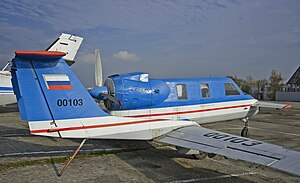 | |
| Role | Three surface utility aircraft |
| National origin | Russia |
| Manufacturer | NPO Molniya |
| First flight | 18 December 1992 |
| Number built | 2 by 2000 |
The Molniya-1 is a six-seater utility aircraft designed and built in Russia during the 1990s.
| Molniya-1 | |
|---|---|
 | |
| Role | Three surface utility aircraft |
| National origin | Russia |
| Manufacturer | NPO Molniya |
| First flight | 18 December 1992 |
| Number built | 2 by 2000 |
The Molniya-1 is a six-seater utility aircraft designed and built in Russia during the 1990s.
The Molniya-1 six-seat aircraft is a three surface design with a forward balanced canard surface and a square section fuselage with a Vedeneyev M14P nine cylinder radial engine in the rear. Twin booms carry fins with balanced and trim tabbed rudders and a high set tailplane, similarly tabbed and balanced. [1]
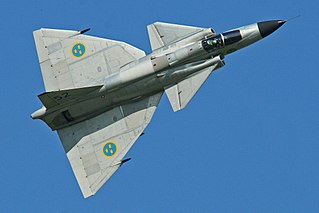
A canard is an aeronautical arrangement wherein a small forewing or foreplane is placed forward of the main wing of a fixed-wing aircraft. The term "canard" may be used to describe the aircraft itself, the wing configuration or the foreplane.

The fuselage is an aircraft's main body section. It holds crew, passengers, and cargo. In single-engine aircraft it will usually contain an engine, as well, although in some amphibious aircraft the single engine is mounted on a pylon attached to the fuselage, which in turn is used as a floating hull. The fuselage also serves to position control and stabilization surfaces in specific relationships to lifting surfaces, which is required for aircraft stability and maneuverability.
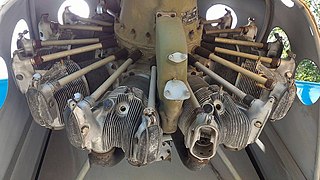
The Vedeneyev M14P is a Russian nine-cylinder, four-stroke, air-cooled, petrol-powered radial engine. Producing 360 hp (268 kW), its design dates from the 1940s, and is itself a development of the Ivchenko AI-14 engine. The engine has been used extensively by the Yakovlev and Sukhoi Design Bureaus. The M14P is also used in some experimental aircraft and kit designs such as the Murphy Moose, Radial Rocket, Pitts Model 12, and others.
It was intended to cover a wide range of tasks including touring, cargo/mail carrying, business flights, aerial photography, patrol and air ambulance services. The three-surface configuration was intended to provide improved safety and fuel efficiency over conventional types, with the rear-mounted engine lowering cabin noise and vibration. [2] It flew for the first time on 18 December 1992. [1]
A Westernised version with a 260 kW (350 hp) Continental TSIO-550-B flat six engine and another, the Moliniya-3 with an Allison 250 turboprop, were proposed. [1] More broadly, the company were considering a number of larger types based on the three surface configuration. [3]

The Continental IO-550 engine is a large family of fuel injected six-cylinder, horizontally opposed, air-cooled aircraft engines that were developed for use in light aircraft by Teledyne Continental Motors. The first IO-550 was delivered in 1983 and the type remains in production.
In 1993 the design received a gold medal at the Eureka-93 World Inventors, Scientific Research and Know-How Salon in Brussels. It was demonstrated at the Le Bourget aero show in 1995. [2] Only two Moliniyas had been built by about 2000. [1]

Le Bourget is a commune in the northeastern suburbs of Paris, France. It is located 10.6 km (6.6 mi) from the center of Paris.
Data from Simpson 2001 [1]
General characteristics
Performance

The Mikoyan-Gurevich MiG-8 Utka was a Soviet experimental aircraft. Built of wood, the aircraft was designed and built in 1945 to test the novel canard configuration. It also used a tricycle undercarriage, the first used by the OKB. It was modified to test a variety of vertical stabilizer and wingtip configurations and was later used as a liaison aircraft for many years by the design bureau.
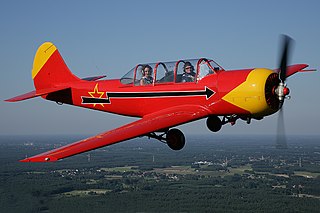
The Yakovlev Yak-52 is a Soviet primary trainer aircraft which first flew in 1976. It was produced in Romania from 1977 to 1998 by Aerostar, as Iak-52, which gained manufacturing rights under agreement within the former COMECON socialist trade organisation. The Yak-52 was designed as an aerobatic trainer for students in the Soviet DOSAAF training organisation, which trained civilian sport pilots and military pilots. Currently the Yak-52 is used in the Fédération Aéronautique Internationale (FAI) World Aerobatic Yak 52 Competition, a popular powered aircraft one-design World Aerobatic Championship.

The Sukhoi Su-26 is a single-seater aerobatic aircraft from the former Soviet Union, powered by a single radial reciprocating engine. The Su-26 has mid-mounted straight wings and fixed landing gear, the main gear mounted on a solid titanium arc.
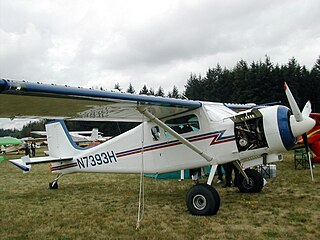
The Murphy Moose is a Canadian high-wing utility light aircraft produced in kit form by Murphy Aircraft of Chilliwack, British Columbia for amateur construction. The Moose can be purchased as a "quick-build" kit which comes partly pre-assembled.

The Sukhoi Su-29 is a Russian two-seat aerobatic aircraft with a 268 kW radial engine. It was designed based on the Su-26 and inherited most of the design and technical features of its predecessor. Due to wide use of composite materials, which make up as much as 60% of the Su-29's aircraft structure, the empty weight is increased by only 50 kg over the single-seat Su-26's empty weight.

The Yakovlev Yak-50 aerobatic aircraft is a single-seat all-metal low-wing monoplane with retractable main wheels and exposed tail wheel. The control surfaces are fabric-covered to save weight. The aircraft is not equipped with flaps.
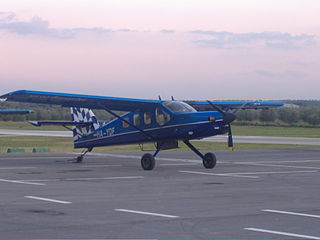
The Technoavia SM92 Finist is a utility aircraft with a STOL capability, designed by the Russian company Technoavia. The maiden flight was on 28 December 1993. It is built by the Smolensk Aviation Plant.

The Altitude Radial Rocket is an American amateur-built aircraft, produced by the Altitude Group of Overland Park, Kansas. The aircraft is supplied as a kit for amateur construction.

The Steen Skybolt is an American homebuilt aerobatic biplane. Designed by teacher Lamar Steen as a high school engineering project, the prototype first flew in October 1970.
The Waco Model W Aristocraft was an American four-seat monoplane, the last aircraft designed and built by the Waco Aircraft Company. It had an unusual configuration with an engine mounted at the front driving a pusher propeller at the rear.
The ICA IS-23 was a single-engined high-wing monoplane with STOL capability that was built in Romania in the 1960s. It was developed into the similar ICA IS-24.

The Dyn'Aéro CR.100 is a French kit built single engine, two-seat monoplane, developed in the 1990s and intended as both an aerobatic trainer and a tourer, primarily for aero club use.
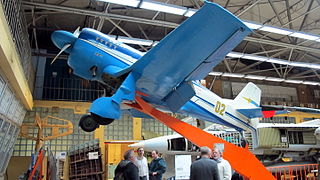
The MAI Kvant was a Soviet aerobatic trainer designed by students at the Moscow Aviation Institute. In October 1967 the aircraft was displayed at the Economic Achievement Exhibition in Moscow. The Kvant was a single-seat low-wing monoplane with a retractable main landing gear and a fixed tailwheel. It was powered by a 360 hp (268 kW) Vedeneyev M14P radial engine. The aircraft held five official FAI world records.
The Quander Airpfeil is a German ultralight trike that was designed and produced by UL Flugzeugbau Quander of Petershagen. The aircraft is supplied complete and ready to fly.
The Schmidtler Enduro is a German ultralight trike that was designed and produced by Ultraleichtflug Schmidtler of Munich. When it was available the aircraft was supplied as a complete ready-to-fly-aircraft.

The Culp Special is an American aerobatic homebuilt aircraft designed and produced by Culp's Specialties of Shreveport, Louisiana. The aircraft is supplied as a kit or in the form of plans for amateur construction.
The Redfern DH-2 is an American homebuilt aircraft that was designed by Walter Redfern and produced by the Walter Redfern Company of Post Falls, Idaho, based upon the 1915 Airco DH.2 fighter aircraft. When it was available the aircraft was supplied in the form of plans for amateur construction.

The Technoavia SP-95 is a Russian aerobatic aircraft, a production version of the earlier SP-91 Slava. The design is similar to the Sukhoi Su-26 family as it was designed by the same designer. It is an aerobatic competition aircraft and can be changed from single-seat to two-seat configuration. The SP-95 is a metal construction low-wing cantilever monoplane with a conventional landing gear with a tail-wheel. It is powered by a Vedeneyev M14P radial piston engine.
The Washington T-411 Wolverine is an American homebuilt aircraft that was produced by Washington Aeroprogress of Seattle, Washington, introduced in the 1990s. When it was available the aircraft was supplied as a kit or in the form of plans for amateur construction.
The Aerostar AG-6 was a prototype Romanian agricultural aircraft of the late 1980s, developed for IAv, of Bacău. The company was later known as Aerostar.